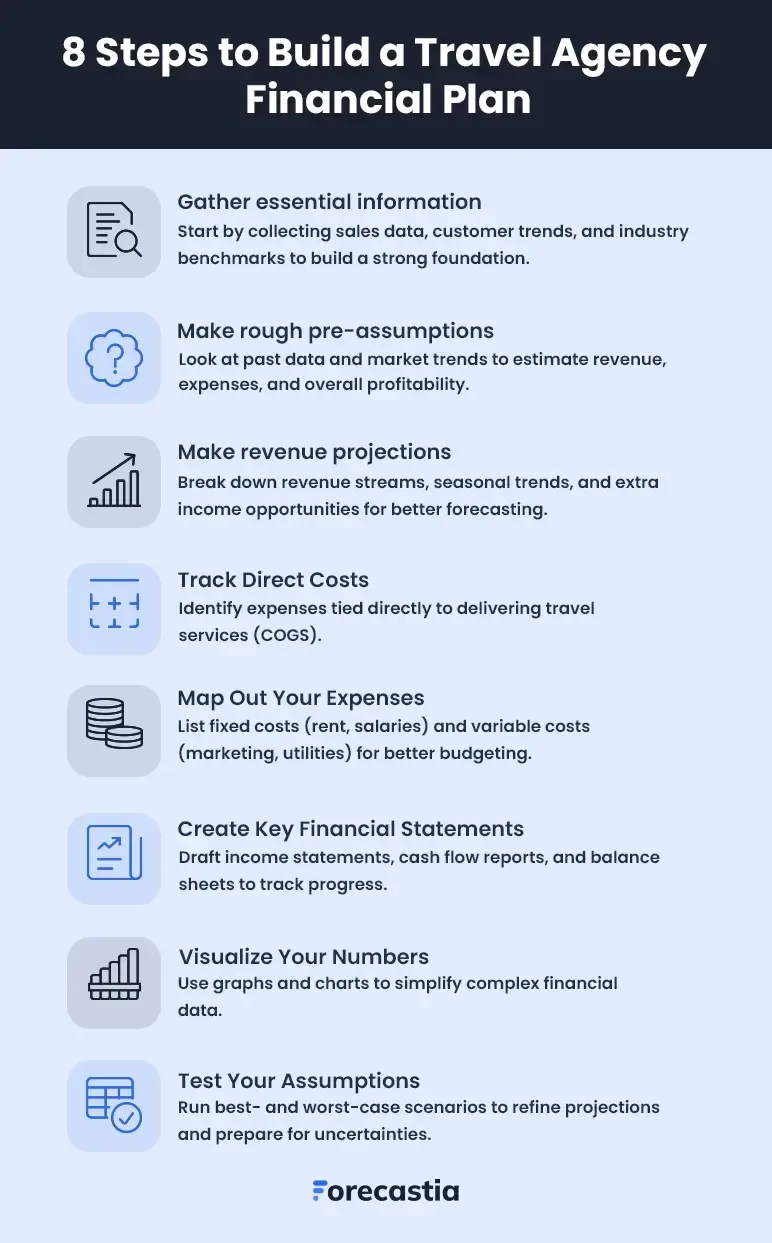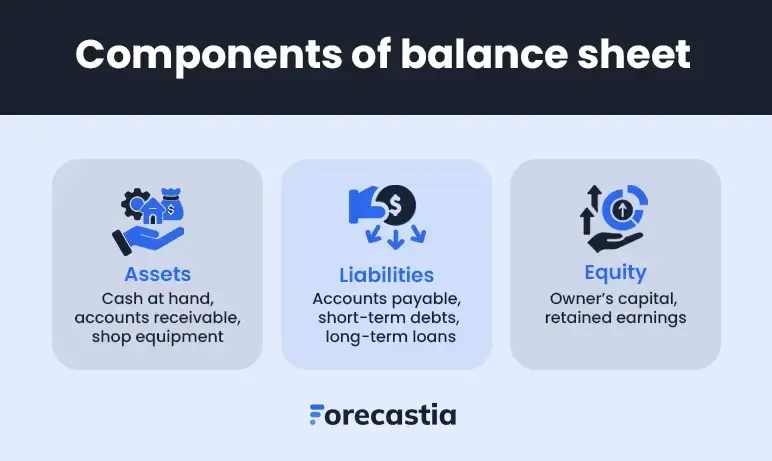People are traveling more than ever—weekend trips, destination weddings, and last-minute getaways are booming. But while the demand is high, so are the costs of running a travel agency.
Between fluctuating ticket prices, marketing expenses, and slow seasons, it’s easy to lose track of your finances. And if you’re not careful, profits can disappear fast.
That’s why you need a financial plan to keep your business steady and growing.
No clue where to start?
No worries, this guide breaks it down step by step, so you can focus on sending people on amazing trips!
How do you build travel agency financial projections?
Creating realistic financial projections for your travel agency involves thorough analysis and meticulous planning to comprehend its financial health and growth potential.
Here’s a step-by-step guide to help you build accurate and actionable projections while ensuring you factor in every detail:

1. Gather essential information
First, collect all the relevant key data that lays the groundwork for accurate financial projections.
This would include travel agency details like:
- Current operations
- Target demographics
- Historical financial performance
- And industry benchmarks.
Start by looking at your booking trends—which months bring the most customers? When do things slow down? Are weekends busier than weekdays? Pay attention to seasonal shifts, holiday spikes, and last-minute bookings.
For new travel agencies, analyze the latest market trends, industry benchmarks, and local competitors to make educated estimates.
Further, understand your customers inside out.
- Who are they?
- What destinations do they prefer?
- What are their travel styles?
Then, track booking trends—monitor demand, seasonal shifts, and pricing changes to offer the best deals.
Most importantly, don’t forget to evaluate the past performance data of your travel agency to understand what drives your business.
Consider analyzing previous revenues, costs, and profits to detect trends and highlight the areas for improvement. Check how some of your travel deals, promotions, or seasonal discounts impacted your bookings and revenue.
That’s how you'll have everything you need to create accurate and actionable financial projections.
2. Make rough pre-assumptions
Now, make some preliminary assumptions for your travel agency’s financial projections based on gathered data. Such estimates will outline your business's revenues, expenses, and profitability levels.
Start by focusing on the basics: How much you’ll make in monthly sales, how much customers will spend on average, and what your operating costs might look like.
Use the understanding of past sales trends, industry benchmarks, and your own research. Even, consider factors like peak travel seasons or new tour packages that could impact your bookings.
Here are a few key metrics to consider while making your assumptions:
- Revenue growth: Forecast a percentage of sales growth, such as 5% growth each year on the back of rising customers or promotions.
- Cost increases: Expect higher air travel or accommodation costs, like a 10% increase on flights during holidays.
- Seasonality: Stock up for peak holiday travel seasons and slow months like September when demand is down.
- Economic conditions: Include inflation, rising wages, or other economic factors that might influence both costs and customers' buying power
Don’t aim for perfection—these are rough estimates to guide your planning that will evolve over time. So, revisit them periodically as actual data comes in.
3. Make revenue projections
Revenue projections are all about figuring out how much money your travel agency might make.
To get started, think about a few simple things: How many trips you book, how often customers return, and their average spending per trip.
Breaking it down step-by-step makes it easier to see your earning potential.
Booking 50 trips a month at an average price of $1,500 per trip brings in $75,000 per month
50 trips × $1,500
= $75,000/month
But, you’ll also need to factor in holidays, peak seasons, or special events—they can increase bookings and boost revenue. On the other hand, off-season or midweek travel might bring in fewer customers.
Additionally, account for other ways to make money. Services like travel insurance, guided tours, premium packages, or corporate bookings can significantly boost your earnings.
By including these extra streams, you’ll get a more accurate picture of what your travel agency can earn.
Revenue projections aren’t merely a dry exercise of crunching numbers—they set realistic expectations while preparing for both the busy times and the quieter ones.
4. Calculate the Cost of Goods Sold (COGS)
The next step is to calculate your Cost of Goods Sold (COGS)—basically the direct costs of providing travel services. This includes airfare, hotel bookings, tour packages, and other expenses directly tied to each trip.
Here's an easy way to do your COGS calculation:

Example:
If your travel agency brings in $100,000 in revenue and spends $40,000 on flights, hotels, and tours, your COGS is $40,000.
5. Estimate operating costs
Next, describe the expected expenses incurred to operate your travel agency.
When assessing the business operational costs, first list the fixed costs that would remain the same month in and out, including office rent, insurance, and employee salaries.
Then, you have to identify variable costs that vary over time. It includes booking platform fees, advertising costs, and seasonal staff wages.
Lastly, add fixed and variable costs to get total operating costs.
Example:
- $5,000 on rent
- $3,000 on booking fees
- $25,000 on wages
- $4,000 on marketing
Thus, monthly operating expenses will be $37,000
Overall, by calculating your operating costs, you can manage your budget and know whether your revenues can cover all the expenses to leave room for profit.
6. Prepare financial statements
After estimating your travel agency's revenue, COGS, and operating expenses, it’s time to draft clear financial statements. These documents are essential for illustrating your travel agency’s financial health and growth potential to prospective investors.
Here are the critical financial statements and reports that you should consider including in your plan:
- Income statement (profit and loss statement)
- Cash flow statement
- Balance sheet
- Break-even analysis
By adding these financial statements, you showcase your financial standing to potential investors so they can make well-informed decisions regarding investment.
We'll explore each of these financial components in greater detail in the upcoming sections, giving you the insights needed to create a strong financial plan.
7. Prepare visual reports
Numbers alone aren't enough. Present your travel agency’s financial data in a visually appealing and easily digestible format that readers can quickly understand and get valuable insights.
Using charts and graphs makes it easier to highlight your travel agency’s key aspects, including revenue trends, expenses, profit margins, and cash flow.
Don’t worry; it’s easy. Use simple bar charts, pie charts, and line graphs to make the data clear. Also, highlight patterns like seasonal sales changes or rising costs to help with planning.
This will not only help analyze financial data but also enable you to communicate key metrics effectively to your team as well as investors.
8. Test assumptions, consider scenario analysis
Finally, take a step back and test the numbers to ensure your projections are more accurate. Try to run different scenarios (best- and worst-case) to see how changes impact your financial outcomes.
For instance, analyze what happens if hotel rates rise by 15% or customer bookings decline during off-peak seasons.
Considering these “what-if” situations helps you identify potential problems in business operations and come up with solutions in advance. It even increases transparency and lets investors better understand your travel agency’s future with different scenarios.
Overall, these test assumptions and sensitivity analyses will help you make strategic decisions and necessary adjustments to keep your travel agency running smoothly.
Key financial statements of a travel agency financial plan
A detailed travel agency financial plan typically includes important financial documents like the income statement, cash flow statement, balance sheet, and break-even analysis.
These reports clearly describe your travel agency's current monetary position and the overall financial strategy to achieve future goals.
Let's explore each statement in detail.
1. Income statement
The income statement is also known as the profit and loss statement. It gives you a solid understanding of your travel agency’s revenue, expenses, gross margin, and net profit for a specific time.
It helps you see whether your business is making enough money to cover its costs and turn a profit.
The gross profit is what you get after subtracting the COGS from the total revenue. This shows how efficiently your travel agency uses its resources.
Further, divide the gross profit by revenue and convert it into a percentage to determine the gross margin.
Then, reduce operating costs like rent, salary, and platform fees to get the EBITDA. Finally, subtract interest, taxes, depreciation, and amortization from the EBITDA to arrive at the net profit of your travel agency—the figure that investors care about the most.
Here’s an example of a mid-sized travel agency’s income statement to demonstrate these calculations:
| Category | Amount ($) |
|---|---|
| Revenue | |
| Customer Bookings Revenue | $85,000 |
| Other Income (Service Fees, Add-ons) | $5,000 |
| Total Revenue | $90,000 |
| Cost of Goods Sold (COGS) | |
| Flights, Hotels, and Tour Costs | $50,000 |
| Total COGS | $50,000 |
| Gross Profit | $40,000 |
| Operating Expenses | |
| Office Rent | $5,000 |
| Employee Salaries | $10,000 |
| Marketing and Advertising | $4,000 |
| Software and Subscriptions | $2,000 |
| Utilities and Miscellaneous | $2,000 |
| Total Operating Expenses | $23,000 |
| Operating Profit (EBITDA) | $17,000 |
| Other Expenses | |
| Loan Interest | $1,000 |
| Taxes | $3,000 |
| Net Profit | $13,000 |
Quick Explanation
An income statement shows how much money the travel agency made, spent, and kept as profit in December 2025.
- Revenue
The agency earned $90,000, mostly from customer bookings and additional service fees.
- COGS
The direct costs of providing trips, like flights, hotels, and tour fees, totaled $50,000.
- Gross Profit
After subtracting COGS, the agency had $40,000 left.
- Operating Expenses
Rent, salaries, marketing, and software costs came to $23,000.
- Operating Profit
After expenses, the agency had $17,000 before taxes and interest.
- Net Profit
After paying interest and taxes the profit will be $13,000.
In simple terms, the income statement tells you if your travel agency is making money and staying financially healthy over time.
2. Cash flow statement
A cash flow statement shows how money is coming in and going out of your travel agency over a certain period. It helps you figure out if you have enough cash to cover your daily expenses.
It’s also great for spotting potential cash shortages, especially during slower months, and demonstrates how much cash is coming from operations compared to things like investments or loans.
To create one, you’ll need to include cash from sales, flights and accommodations, and other overhead expenses. It highlights how much money your travel agency is making and spending during that period.
Cash Flow Statement for Bright Horizons Travel Agency – December 2025
Here’s how the money moved throughout the month:
Operating Activities
The agency made $85,000 from bookings by customers.
- Payouts of Suppliers: $50,000
- Expenses: $18,000
85,000 - (50000 - 18000)
=17000
So a net cash flow from operations is $17,000
Investing Activities
- The agency upgraded its booking software and bought new office equipment, costing $6,000.
Financing Activities
- A $5,000 loan repayment was made, reducing long-term debt. No new loans were taken.
Ending Cash Balance
- The agency started the month with $15,000 in cash.
- After all expenses and investments, it ended December with $21,000 in cash, showing positive cash flow.
This means the business brought in more money than it spent, keeping it in a strong financial position heading into the next month.
That said, it’s a good illustration of how well your business is at generating cash. The precision of your projections in these aspects directly impacts the reliability of your cash flow.
So, be realistic with the assumptions you make in the cash flow statement. Use industry standards and consider market situations to ensure accuracy.
3. Balance sheet
A balance sheet gives a quick snapshot of your travel agency’s financial position for a specific timeframe. It shows what the travel agency owns, what it owes to others, and what’s left for you.
After all, it covers these key elements:

- Assets
Assets include things like cash on hand, money owed by customers (accounts receivable), and office equipment.
- Liabilities
Liabilities cover any debts, like short-term loans or long-term borrowings.
- Equity
Equity is what’s left after subtracting liabilities from assets—essentially, the business’s remaining value. The remaining earnings after liabilities have been deducted from assets
Thus, Assets = Liabilities + Equity
Owner’s EquityRetained Earnings$18,000
| Category | Details | Amount ($) |
|---|---|---|
| Assets | Current Assets | |
| Cash on Hand | $20,000 | |
| Accounts Receivable | $15,000 | |
| Prepaid Expenses | $5,000 | |
| Total Current Assets | $40,000 | |
| Fixed Assets | ||
| Office Equipment | $10,000 | |
| Company Vehicles | $8,000 | |
| Total Fixed Assets | $18,000 | |
| Total Assets | $58,000 | |
| Liabilities | Accounts Payable | $7,000 |
| Business Loan | $20,000 | |
| Employee Salaries Payable | $5,000 | |
| Total Liabilities | $32,000 | |
| Owner’s Capital | $8,000 | |
| Total Equity | $26,000 | |
| Total Liabilities & Equity | $58,000 |
In this example, the agency has $58,000 in assets, balanced by $32,000 in liabilities and $26,000 in owner’s equity, meaning the business is financially stable.
Investors really pay close attention to the balance sheet because it shows them your travel agency’s financial structure, return on investment (ROI), and overall stability.
It also provides an idea of the cash that is available to you, how the money is blocked, and what kind of solid business you are running.
4. Break-even analysis
We all know that profit is the all-time motive of all travel agency. The real question is: When does the money actually start coming in?
A break-even analysis fits the bill at this stage. It shows exactly how much you’ll need to generate in revenue for all the costs to be recovered—no profit and no loss; just breaking even.
Let's take an example to see how it works.
For a travel agency:
- Fixed costs: $12,000 (including office rent: $6,000, utilities: $2,000, and salaries: $4,000)
- Variable costs: $30,000 (flights, hotels, commissions)
- Revenue: $90,000
- Contribution Margin: ($90,000 - $30,000) ÷ $90,000 = 0.6667 (or 66.67%)
- Break-even sales calculation: $12,000 ÷ 0.6667 = $18,000

So, this travel agency needs to generate at least $18,000 per month to cover all costs and break even.
This analysis shows exactly how much revenue is needed to reach the point where your total sales just cover your costs, causing no profit or loss.
In addition, this will give potential investors or lenders a fair idea of when your travel agency would be profitable.
Download free travel agency financial projections example
Creating a travel agency financial plan from scratch seems overwhelming. After all, Excel sheets are tiring and endlessly long. But no worries! We’re here to help you with our free travel agency financial plan sample.
It covers all the key components of a travel agency's financial projection, such as sales forecast, P&L or income statement, balance sheet, cash flows, and break-even analysis, simplifying the entire financial planning process to help you get started.
Build accurate financial projections using Forecastia
That’s it! We’ve discussed almost everything about creating travel agency financial projections in this guide. Now, it should be much easier for you to put that knowledge into action and start planning.
But if it still feels like a lot to handle, don’t worry; Forecastia is the only AI-powered financial forecasting tool you need to make the process simple and stress-free.
It’s specifically designed for businesses looking to build accurate financial projections, anticipate future cash flows, and analyze overall financial performance—all without using spreadsheets!
Frequently Asked Questions
What are the key financial statements in a travel agency's financial plan?
To manage your finances effectively, you need to track key statements:
- Income statement: Shows revenue, expenses, and profits over a period.
- Balance sheet: Lists assets, liabilities, and equity to assess financial health.
- Cash flow statement: Tracks cash inflows and outflows to maintain liquidity.
What are common operating expenses in a travel agency financial plan?
Running a travel agency comes with various ongoing costs, including:
- Fixed costs: Office rent, employee salaries, and software subscriptions.
- Variable costs: Booking platform fees, travel agent commissions, and advertising.
- Miscellaneous expenses: Customer service, insurance, and business licenses.
How do I create financial projections for my travel agency?
Projecting your agency’s finances requires a structured approach:
- Estimate revenue: Analyze expected bookings and pricing.
- Deduct direct costs: Account for flights, hotels, and commissions.
- Include operating expenses: Factor in rent, salaries, and marketing.
- Adjust for seasonality: Plan for peak and slow travel periods.
How often should I update my travel agency’s financial projections?
Regular updates keep your financial plan accurate and useful:
- Quarterly reviews: Adjust based on booking trends and market shifts.
- Major business changes: Update projections when launching new services.
- Unexpected costs: Revise when dealing with rising supplier prices or economic changes.
How to use the travel agency financial projections template?
A financial template simplifies tracking and forecasting:
- Enter revenue estimates: Input expected monthly bookings.
- Include direct costs: Add supplier expenses like flights and hotels.
- Factor in overhead costs: List rent, payroll, and marketing expenses.
- Analyze the results: Use the data to plan budgets and business strategies.

